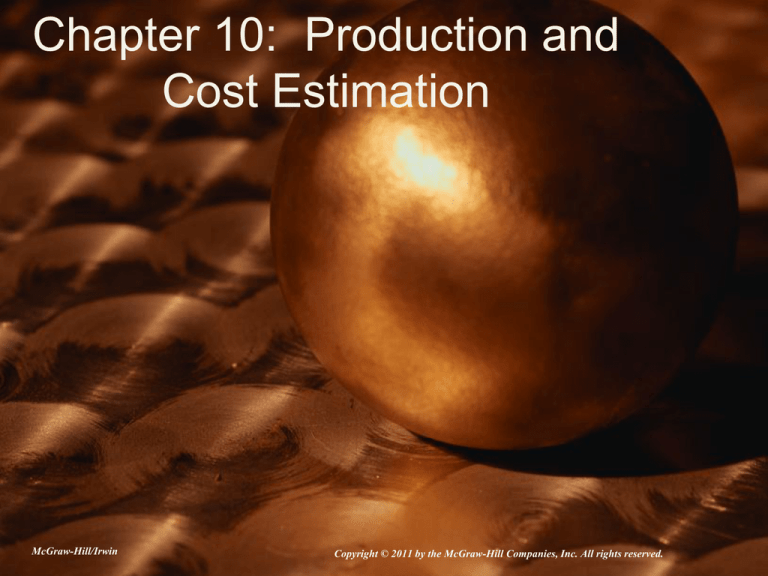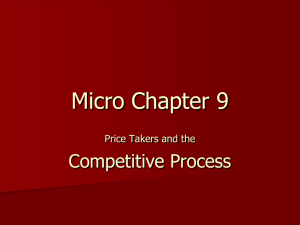
Chapter 10: Production and
Cost Estimation
McGraw-Hill/Irwin
Copyright © 2011 by the McGraw-Hill Companies, Inc. All rights reserved.
Empirical Production Function
• An empirical production function is the
mathematical form of the production
function to be estimated
10-2
Empirical Production Function
• Long-run production function
• A production function in which all inputs are
variable
• Short-run production function
• A production function in which at least one
input is fixed
10-3
Empirical Production Function
• Cubic empirical specification for a shortrun production function is derived from a
long-run cubic production function
• Cubic form of the long-run production
function is expressed as
Q aK L bK L
3 3
2
2
10-4
Properties of a Short-Run Cubic
Production Function
3
2
Q AL BL
• Holding capital constant, short-run cubic
production function is derived as follows:
Q aK L bK L
3 3
2
2
AL BL
3
2
Where A aK 3 and B bK 2
10-5
Properties of a Short-Run Cubic
Production Function
3
2
Q AL BL
• The average & marginal products of
labor are, respectively:
AP Q L AL BL
2
MP Q L 3AL 2BL
2
10-6
Properties of a Short-Run Cubic
Production Function
3
2
Q AL BL
• Marginal product of labor begins to
diminish beyond Lm units of labor
• Average product of labor begins to
diminish beyond La units of labor
B
B
Lm
and La
3A
2A
10-7
MP & AP Curves for the Short-Run Cubic
Production Function (Figure 10.1)
Q = AL3 + BL2
10-8
Properties of a Short-Run Cubic
Production Function
3
2
Q AL BL
• To have necessary properties of a
production function, parameters must
satisfy the following restrictions:
A < 0 and B > 0
10-9
Estimation of a Short-Run
Production Function
• To use linear regression analysis, the
cubic equation must be transformed into
linear form
• Q = AX + BW
• Where X = L3 and W = L2
• Estimated regression line must pass
through the origin
• Specify in computer routine
10-10
Estimation of a Short-Run
Production Function
• Estimate using data for which the level
of usage of one or more inputs is fixed
• Usually time series data are used
10-11
Estimation of a Short-Run
Production Function
• Data collection may be complicated by
the fact that accounting data do not
include firm’s opportunity costs
• Capital costs should reflect not only
acquisition cost but any foregone rental
income, depreciation, & capital gains/losses
10-12
Estimation of a Short-Run
Production Function
• Nominal cost data
• Data that have not been corrected for the
effects of inflation
• Must eliminate effects of inflation
• Correct for the influence of inflation by
dividing nominal cost data by an
appropriate price index (or implicit price
deflator)
10-13
Properties of a Short-Run Cubic
Cost Function
TVC aQ bQ cQ
2
3
• Average variable cost & marginal cost
functions are, respectively:
AVC a bQ cQ
2
SMC a 2bQ 3cQ2
10-14
Properties of a Short-Run Cubic
Cost Function
TVC aQ bQ cQ
2
3
• Average variable cost reaches its
minimum value at:
Qm b 2c
10-15
Properties of a Short-Run Cubic
Cost Function
TVC aQ bQ cQ
2
3
• To conform to theoretical properties,
parameters must satisfy the following
restrictions:
a > 0, b < 0, and c > 0
10-16
Properties of a Short-Run Cubic
Cost Function
• Cubic specification produces S-shaped
TVC curve & U-shaped AVC & SMC
curves
10-17
Properties of a Short-Run Cubic
Cost Function
• All three cost curves employ the same
parameters
• Only necessary to estimate one of these
functions to obtain estimates of all three
• In the short-run cubic specification, input
prices are assumed constant
• Not explicitly included in cost equation
10-18
Summary of Short-Run Empirical
Production Functions
Short-run cubic
production equations
Total product
Q AL3 BL2
Average product of labor
AP AL BL
Marginal product of labor
MP 3 AL2 2BL
Diminishing marginal
returns
B
begin at Lm
3A
Restrictions on parameters
2
A < 0 and B > 0
10-19
Summary of Short-Run Empirical
Cost Functions
Short-run cubic
cost equations
Total variable cost
Average variable cost
Marginal cost
Average variable cost
reaches minimum at
Restrictions on parameters
TVC aQ bQ2 cQ3
AVC a bQ cQ2
SMC a 2bQ 3cQ
2
b
Qm
2c
a > 0, b < 0, and c > 0
10-20
Problem
Mercantile Metalworks, Inc. manufactures wire carts for
grocery stores. The production manager at Mercantile
wishes to estimate an empirical production function for
the assembly of carts using time-series data for the last
22 days of assembly. L is the daily number of assembly
workers employed and Q is the number of carts
assembled (completely) for that day. Mercantile pays its
assembly workers $160 per day in wages and benefits.
10-21
1. Use Excel to estimate the following short run cubic
production function:
Q AL BL
3
2
Do the parameter estimates have the appropriate
algebraic signs? Are they statistically significant at the
1 percent level?
2. What are the estimated total, average, and marginal
product functions from your regression results?
3. At what level of labor usage does average product
reach its maximum value? In a day, how many carts are
assembled when average product is at its maximum?
What is average variable cost when average product is
maximized?
10-22










